Wembley: England
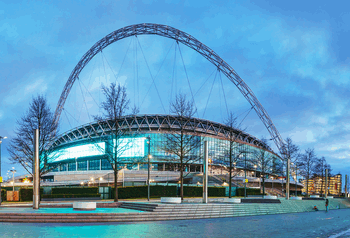
photo.ua / BigStock.com
Wembley Stadium is, arguably, the most famous ground in world football. Although the original stadium was demolished in 2003, the current version of the home of England’s international team was built on the same site and opened to the public in 2007. The current iteration of Wembley was designed by HOK Sport and Fosters and Partners. There is a retractable roof on top of the ground and, of course, the famous Wembley Arch. Ironically, despite being one of the icons of Britain, it was built by an Australian firm called Multiplex and it cost about £798 million.
Wembley isn’t just the home of the England international team. It is also the ground that hosts the finals of the most important domestic club competitions in the country. The FA Cup final is held at Wembley in May, whilst The League Cup final is hosted their at the end of February. The FA Community Shield, which is a game played between the winners of the League and the winners of the FA Cup, is also held at Wembley before the start of each new season.
Fans of lower league teams get to head to Wembley from time to time, too. The stadium hosts the Football League Trophy final as well as the Football League play-offs. It has also been the ground for the final of the UEFA Champions League in both 2011 and 2013. During the 2012 Olympics, Wembley was used to host the Gold medal matches for the football tournament. Even if you’re not a football fan then you shouldn’t rule out the possibility of a trip to Wembley; it has been known to host the rugby league Challenge Cup final as well as the NFL International series and nu-merous music concerts.
Tottenham Hotspur moved to Wembley for the start of the 2017-2018 campaign. During this time their former stadium, White Hart Lane, was closed whilst a completely new ground was built in its place.
Stats
| Wembley Stats | |
|---|---|
| Year Opened | 2007 |
| Capacity | 90000 |
| Average Attendance | 85000 |
| Record Attendance | 89874 (Portsmouth v Cardiff City (2008)) |
| Pitch Size | 105 x 68 (7140) |
| Owner | The Football Association |
| Clubs Hosted | England |
| First Fixture | Geoff Thomas Foundation Charity XI v Wembley Sponsors Allstars (17/03/2007) |
| England Stats | |
|---|---|
| Year Founded | 1870 |
| Nickname | The Three Lions |
| Rivals | Germany, Scotland, Wales |
| Previous Stadiums | Wembley |
| Kit | White (Home) / Navy Blue (Away) |
| Training Ground | St. George's Park |
| Team Owner | The Football Association |
| Record Goalscorer | Wayne Rooney (53) |
| Record Appearances | Peter Shilton (125) |
Wembley Photos
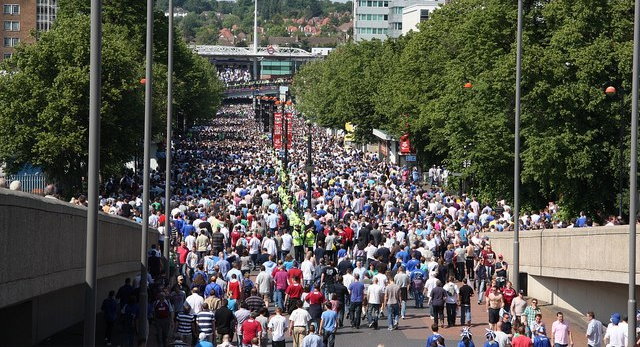
Richard Croft [CC BY-SA 2.0]
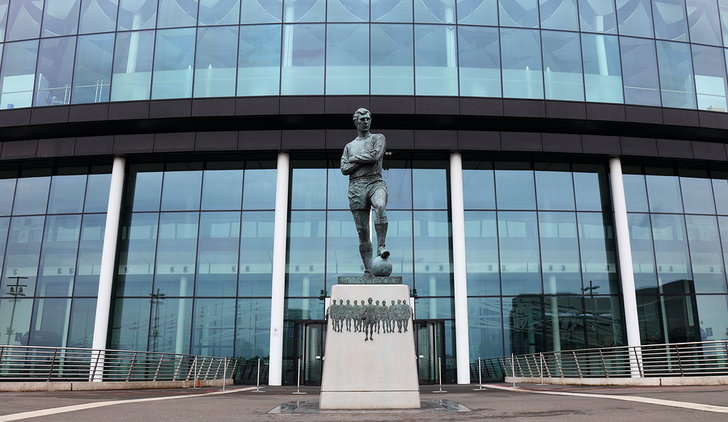
majeczka-majeczka / BigStock.com
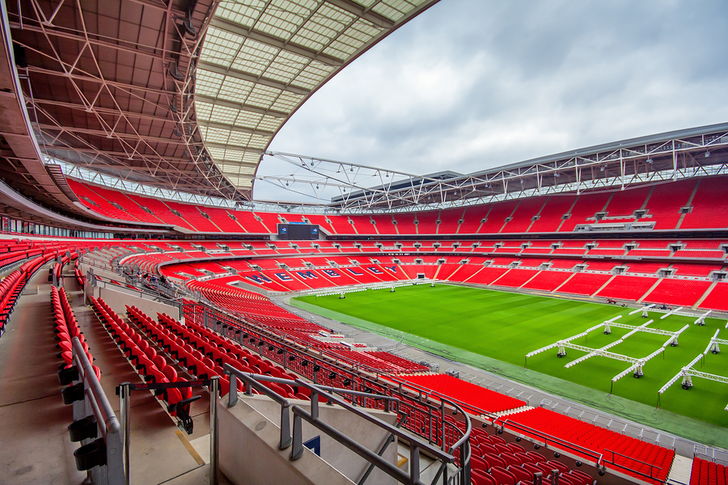
Andrew Barker / BigStock.com
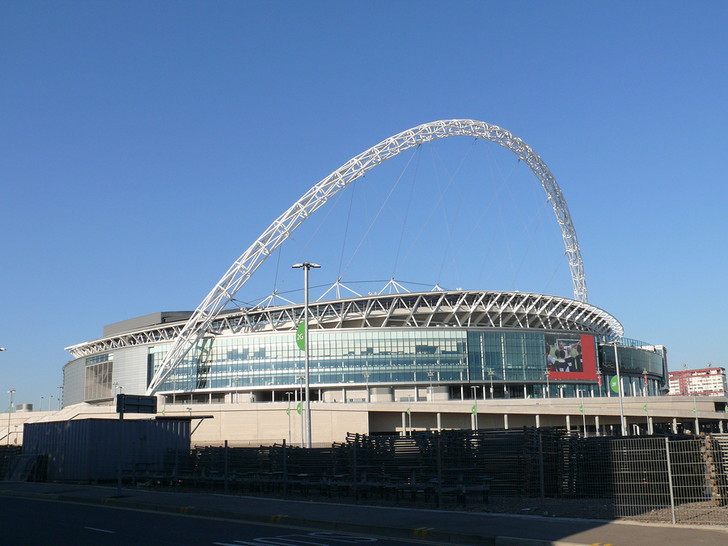
delbaro / BigStock.com
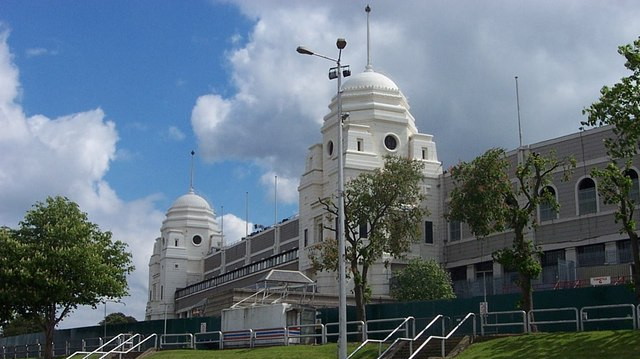
Merv Payne [CC BY-SA 2.0]
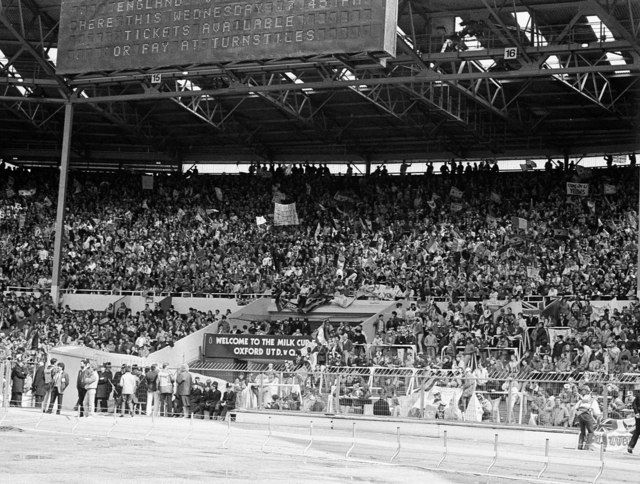
Steve Daniels [CC BY-SA 2.0]
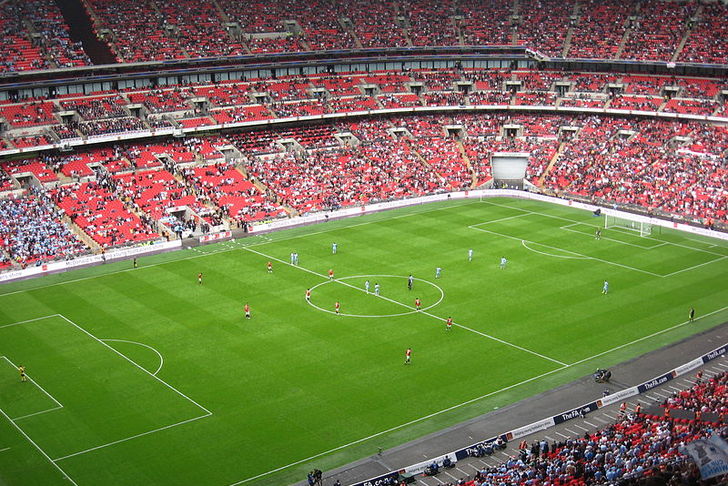
By Oldelpaso (Own work) [CC BY-SA 3.0]
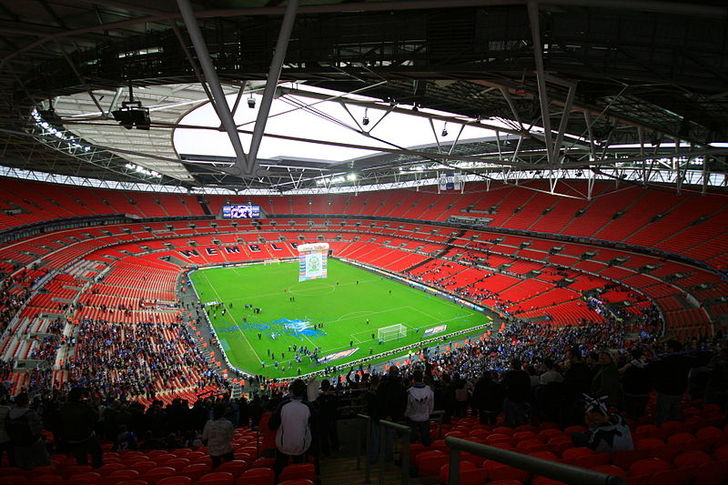
By Ceaton89 (Transferred from en.wikipedia to Commons.) [CC BY-SA 3.0 or GFDL]
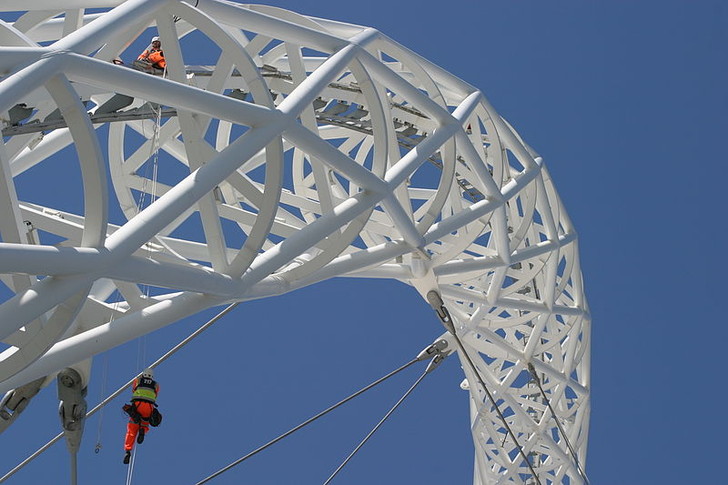
Wembley Seating Plan and Where to Sit

Wembley Stadium has, like most modern grounds in England, a bowl shape to its design. It has three levels, with executive boxes around the entire ground. It also has four sides in the same classic way that all grounds do.
Unlike with most stadiums in England, the four sides of Wembley don’t have names. Instead the ground is broken up into 14 different sections, each given a letter so you know where in the ground you’re heading to. Where exactly your seat is will then depend on whether or not you’re on level 1, level 2 or level three.
England Ticket Prices
It is fair to say that ticket prices for games at Wembley can vary significantly and aren’t always easy to get to grips with. Prices for the FA Cup final, for example, will be much more expensive than a friendly game between England and France.
For the 2015-2016 season’s League Cup final Liverpool and Manchester City were each allocated about 31,500 tickets at Wembley. In the instance of the final you are only able to purchase tickets from the clubs directly and can’t buy them through Wembley Stadium itself. Prices are broken down into 5 different categories depending on where in the ground you are hoping to sit and whether or not you’re a concession:
The League Cup Final 2016
- Category 1 – £100 – £50
- Category 2 – £90 – £45
- Category 3 – £72 – £36
- Category 4 – £56 – £28
- Category 5 – £40 – £20
In March of the same year England hosted the Netherlands in a friendly match as both teams geared up for the Euros that summer. It was the 20th time that the two teams faced each other, the previous occasion being at Wembley in February 2012 when the home team lost 3-2 thanks to an Arjen Robben injury-time winner. Tickets were priced as follows:
Friendly Match v Netherlands
- Category 1 – £65 – £55
- Category 2 – £55 – £45
- Category 3 – £45 – £35
- Category 4 – £35 – £25
Both the FA Cup final and the semi-finals are held at Wembley. Obviously the prices for each are different, with the final coming in pricier than the semis. Much like with the League Cup final and the friendly game against the Netherlands, the prices are categorised and clubs are able to offer a further £10 concession on certain tickets.
FA Cup Semi-Finals 2016
- Category 1 – £65
- Category 2 – £55
- Category 3 – £45
- Category 4 – £35
FA Cup Final 2016
- Category 1 – £125
- Category 2 – £95
- Category 3 – £75
- Category 4 – £50
We haven’t even begun to scratch the surface of the ticketing prices at Wembley, given the sheer variety of events that take place at the stadium. Hopefully, though, we’ve given you a good idea of the sorts of prices you’ll be asked to pay depending on the event you’re looking to attend. Wembley themselves say that only about 20% of the tickets available are in the highest price bracket.
How To Get England Tickets
It is standard operating procedure for Wembley to release the tickets for club matches held at the stadium to the clubs themselves. For the League Cup final mentioned before, for example, it was Liverpool and Manchester City that sold the tickets to their fans. The only things that were sorted through Wembley directly were the corporate tickets.
If you’re hoping to get tickets for England matches then you’ll need to do so through The Football Association. You can do that by heading to their ticketing website or by calling their ticket hotline. You can also join Club Wembley, Wembley’s own hospitality section of the ground that will give you access to such events on a regular basis.
Where to Buy
Getting To Wembley
Wembley is located just outside of Central London, so getting there isn’t as tricky as it could be. In fact, because of the fact that London is seen by many to be the most important city in the country you’ll actually find your options of getting to the ground to be numerous and easy to use.
Train – Wembley is just nine minutes from Marylebone via Chiltern Railways, and two stops from Baker Street. The nearest tube stops are Wembley Park Station, which is on the Jubilee and Metropolitan Underground lines, Wembley Stadium Station, which is serviced by the already mentioned Chiltern Railways, and Wembley Central Station, which is on the Bakerloo line, the London Overground and both London Midland and Southern lines.
Bus – Bus numbers 18, 83, 92 and 224 all serve Wembley. If you want to know where you can catch them from then the Transport for London app and website are ideal resources. It’s also worth bearing in mind that National Express is the Official Coach Supplier for Wembley, with the company running services from more than 55 locations around the country.
Car – Because the public transport options are so good at Wembley it is recommended that you avoid driving if possible. If you’re still determined to drive, though, then you’ll be able to find more specific directions by using the post code HA9 0WS.
By Air – London has more airports serving it than any other city in England. You can fly into Heathrow, Gatwick, London City, Luton or Stansted airports and make your way to Wembley from there. They all have excellent connections to the centre of London itself.
Taxi – Much like driving a private car, it’s recommended that you take public transport rather than get a taxi if you’re trying to travel through Central London. If you are determined to get one, though, be aware that prices will vary considerably depending on how far away you’re travelling from and how heavy the traffic is you’ll be making your way through. As an example, a taxi from Euston to Wembley will take about 45 minutes and cost you around the same amount.
Parking Near Wembley
There are numerous official parking spaces near to the ground, but parking options are limited. You’ll also struggle to park near to the stadium on backstreets or the like. As with most grounds in London you’d be better advised to park outside of London but somewhere that is on the same line as the various Wembley train stations so that you can catch public transport in from outside of the city.
Useful Resources
- Parking - Just Park
Wembley Hotels
London is a vast, sprawling city full of numerous different suburbs that are each like a mini-city all of their own. Your hotel options, then, are plentiful. The further afield you’re happy to go the more choices you’ll have at your disposal, but we’ve picked a few of our own to make life simpler for you.

Ibis London Wembley - £50+
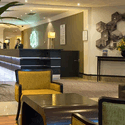
Holiday Inn Wembley - £70+
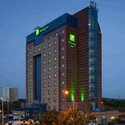
Holiday Inn Brent Cross - £125+
Pubs and Bars Near Wembley
London is the capital city, so to suggest that there’ll be a pub or two for you to get a quick drink in before the game is something of an understatement. Here we’ve picked some of the choice locations you can head to for a pre-match pint and a bite to eat.
Coast to Coast
The Swan
Fox And Goose Hotel
Facilities
in truth, Wembley is a little sterile behind the scenes. The concourses are generally concrete-based with little to no personality to speak of. It’s totally understandable, though, when you consider the number of different events the stadium has to host without suggesting favouritism to one team or another.
Whilst the concourses might be somewhat bland and faceless, the facilities within them are second to none. There are plenty of places to get a varied bite to eat – from pizzas through to hotdogs – as well numerous different drinks outlets. You’ll also be able to find a couple of kiosks where you’ll be able to place a bet before the game you’re going to watch.
Prices
- Programme: £10
- Pie: £4.5
- Cup of tea: £2.5
- Beer: £5
Hospitality
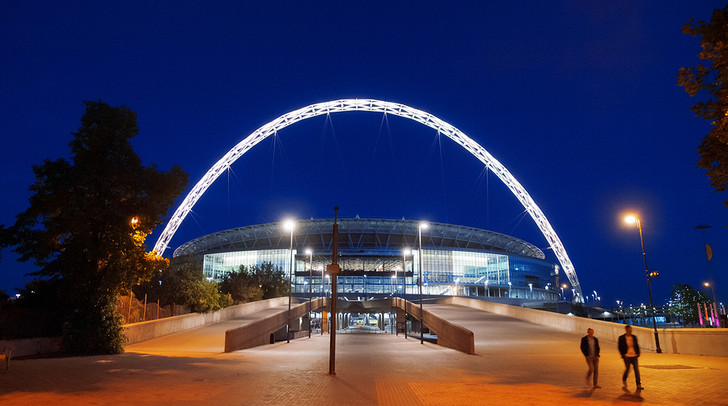
As the largest stadium in the country, the number of hospitality options at Wembley are almost over-whelming. They also differ from event to event, so the choices you’ll have available to you for a Rihanna gig, for example, are significantly different from the packages you’ll get if you want to see the Barbarians play South Africa in November.
The Bobby Moore Club is one of the top-end hospitality options available at Wembley. Go down this route and you’ll never want to go back to a regular seat. You’ll enjoy a champagne reception, a three-course meal and a selection of wines and beers. You’ll have luxury seats on the halfway line and close to the dugouts, so you’ll get a similar view to the one experienced by the manager and his staff.
Other hospitality packages at Wembley tend to be named after precious materials. There is a Diamond package, for example, that offers a champagne reception, a three-course pre-match meal, a complimentary bar for three hours before the game and one hour afterwards and you’ll also get access to a cash bar during the match itself. There’s also a Sapphire package that will see you have access to a pre-match buffet, complimentary bar and Premium tickets on the Club Wembley Level Two section of the stadium.
Private Hire
There is virtually no event that you’ll want to host that you won’t be able to host at Wembley Stadium. the Bobby Moore Room is the ground’s biggest space and offers the ability to host any occasion. Fancy having a gala event? They’ll take it in their stride. How about a fashion parade? Just tell them where to lay out the runway. The Bobby Moore Room is the ‘jewel in the crown’ of Wembley’s private hire options. It has two levels, a mezzanine room and sweeping staircases that link it all together. The room boasts banqueting facilities for up to 1900 people, cocktails for up to 3250 and a square metre space of 3480.
The Great Hall has a size of 2080 square metres, good proportions and a glass wall offering cracking views of the Olympic Way. It is a great space for events such as an exhibition or a dinner dance. You can have a cocktail party for 2000 people, a theatre arrangement for 1800 or use it for whatever you fancy if you have a more specific idea about how to use the space.
The Wembley Suite, meanwhile, is a smaller and more intimate space. It is a self-contained location, so you’ll get privacy as well as a classy location. It is the perfect location for things like pre-event registration, small cocktail parties, or any unique occasion that will have smaller numbers and requires a little bit more intimacy than the larger suites and rooms that Wembley Stadium has to offer.
Stadium Tours & Museum
As one of the most famous grounds in the world, Wembley would be missing a trick if they didn’t offer tours of the ground. They last around 75 minutes and they take in plenty of the stadiums more well-known locations. You can take a seat on the bench in the changing room, for example, or have a sit down in the seat the Roy Hodgson, the England manager, takes when he talks to the press.
As part of the tour you’ll be taken to different parts of the stadium so you can see what the views are like from various seats. You’ll also get to find out how the players feel when they walk down the tunnel to the side of the pitch. Have you ever wondered what it would be like to climb all 107 of the Trophy Winner’s steps? You’ll get to find out if you take the tour.
Most of the time you’ll also get to see the Royal Box and touch the FA Cup trophy, but between February 29th and July 31st this won’t be possible on the tour. Don’t think that that makes the tour pointless, however. You’ll still get to see some of the most famous treasures in football. There is the crossbar from the 1966 World Cup final, for example, as well as the Jules Rimet Trophy that England lifted in that most famous of years.
Tours leave every hour at the least every day of the week and they cost £19 for adults, £11 for children, seniors and students, or £45 for a family ticket. Wembley also offers VIP Access Tours that take in even more locations than the normal tour. These are for smaller groups with a private guide and are charged at £55 for every two people.
About England
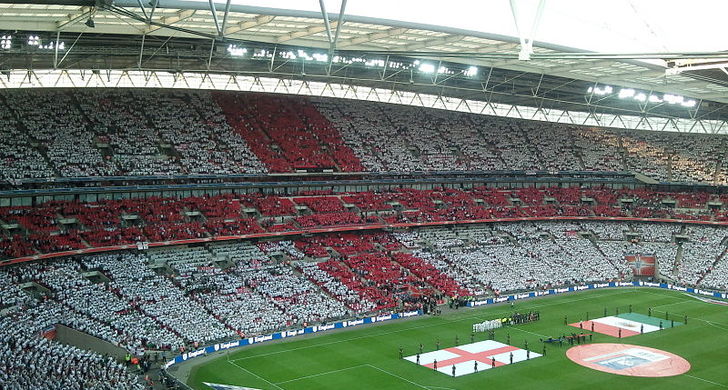
Though Wembley has played host to countless teams during its existence – to the extent that Liverpool fans used to call the ground ‘Anfield South’ – there is really only one team that can be associated with the national stadium and that’s England. The team represents not just the country of England but also the Crown Dependencies of Jersey, Guernsey and The Isle Of Man. It is controlled by The Football Association, the same governing body that rules football in England.
England is one of the oldest national teams in world football along with Scotland, the two teams playing against in each other in the first international match in the history of the game in 1872. The main tournaments that England play in are the World Cup and the European Championships, commonly called the Euros.
Though England have never won the Euros, they won the World Cup when they beat West Germany 4-2 after extra time in 1966. The final for the tournament that year was held in Wembley, with England’s home advantage playing a huge part in their victory. Since 1966 the closest they have come to repeating the feat was reaching the semi-finals of the competition in 1990 when they beaten, ironically, by West Germany.
Six years later and England were back in the semi-finals of a competition and playing against Germany, only this time it was the Euros. The match was hosted at Wembley and the winners knew they would be facing the Czech Republic in the final. The hosts took the lead after just three minutes when Alan Shearer scored, only for Kuntz to equalise 13 minutes later. No more goals in the remainder of the match saw it go to penalties and, much like in 1990, Germany won through.
The discussion surrounding the country’s top-scorer is always a debatable one, with many claiming that Wayne Rooney’s goals came in easier matches that the goals scored by the likes of Bobby Charlton or Gary Lineker. Whatever the ins and outs of the debate, Rooney tops the official chart with 51 goals in 109 games. Charlton is second with 49 goals in 106 games, whilst Lineker has the best goals per game ratio with 48 goals in 80 games. Rooney, of course, can still extend his tally as he is the only player who is still active, lining up for Roy Hodgson’s England every time he’s fit and able to do so.
Wembley History
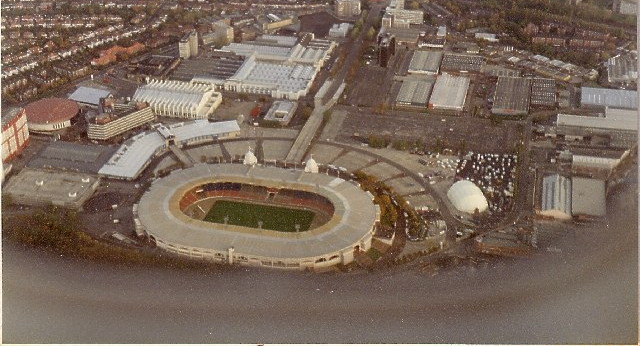
The conversation surrounding Wembley can be split into two parts: Before the re-build and after it. Unfortunately for the England national team and its fans the success that they have witnessed was all in the original Wembley Stadium. The new Wembley is yet to see the team it hosts win a major trophy, and it is unlikely to do so until 2020 when the semi-final and finals of the Euros will be held there.
Just because England haven’t seen much success at the new Wembley doesn’t mean that no other teams have. In 2007 Derby County beat West Brom 1-0 and became the first team to win themselves promotion to the Premier League from the new stadium. In May of the same year Chelsea beat Manchester United by the same scoreline to win the FA Cup, with Didier Drogba being the first player to score a goal in the new ground. Interestingly, the win meant that Chelsea completed a curious double of being the last team to win the FA Cup in the old Wembley and the first team to win it in the new one.
The 90,000 seats in Wembley make it the second largest stadium in Europe, 9354 seats less than those boasted by Camp Nou in Barcelona. There are over 2000 toilets in the ground, 35 miles worth of heavy-duty power cables and the construction involved the use of 23,000 tonnes of steel. Another interesting fact about Wembley is that the pitch is actually 13 foot lower than the pitch was previously.
Despite its overwhelming association with football, Wembley has also been the location for numerous music events. The first ever concert in the newly designed stadium was George Michael, though it was supposed to be Bon Jovi. The stadium was late in completion meaning that the American rock group had to relocate to elsewhere. Oasis, Take That, Metallica, The Killers and even Madonna have all performed gigs at Wembley stadium. It is unlikely the stadium will ever see any-thing as spectacular as the Live Aid concert that the old Wembley witnessed, but with around 80,000 fans in attendance at most concerts it’s fair to say that the atmosphere is impressive regardless.
Future Developments
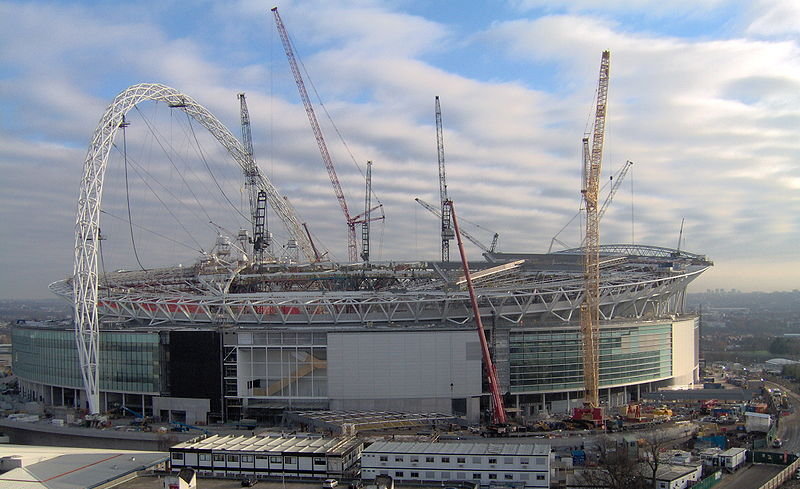
There are no immediate plans to develop Wembley Stadium any further, though the surround-ing region will continue to go through regeneration in the coming months and years.
